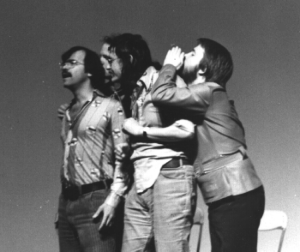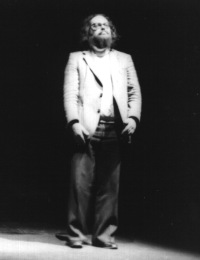
The Horsemen performing at the
'First West Coast International Sound Poetry Festival', San Francisco, 1977.

The Horsemen performing at the
'First West Coast International Sound Poetry Festival', San Francisco,
1977.
The earliest text-sound pieces were generally done the Swedish Radio -- several of these first works by Lars-Gunnar Bodin and Bengt Emil Johnson were just a single audio channel for monophonic radio broadcast, even though there was access at that time to multiple audio channel recorders. The acoustical space described by the multiple layers of these works was largely defined by timbre. Any localizing or spacial information was perceptually inferred in the work, much like one can depict a three dimensional object on a two dimensional piece of paper.
When this kind of work was presented in an audience/performance kind of situation, it took on a format that was similar to the tape electro-acoustic music concerts of the time. Two or four channel pieces were produced which played through loud speakers on stage or in the 4 corners of the room in case of the 4 channel works. Ideally, the audience would passively sit in a dark or semi-darken room and look at the speakers and try to focus on the sounds. As this kind of performance style progressed, a two channel work would be manipulated during its playback, through a large array of speakers, in a technique called diffusion, and movement of the sound could be articulated in complex ways which could mimic unseen visual movements.
 Sten Hanson performing 'How are You?' at the
Sten Hanson performing 'How are You?' at the
11th International Sound Poetry Festival, Toronto, 1978.
Photo by Larry Wendt.
More commonly though, in the case of text-sound
compositions, small abstracted theatrical gestures would be performed by the
composer with the tape playback. An example of this, is Sten Hanson's piece
'How are You?', where the composer would bow and then try to run through the
audience and shake everyone's hand during the playback of the tape.
There is a performance component therefore implied in this way of working. Often taking the form of the performance art models of that time, in particular that of FLUXUS. This 'performability' can be demonstrated within the formulations of text-sound depending upon the venue in which the piece appears. Likewise, print representations of a text-sound piece are often depicted in a concrete or visual poetry style. Text-sound for the video media as well as those forms of expression which exist in the digital realms have also been and are being explored.